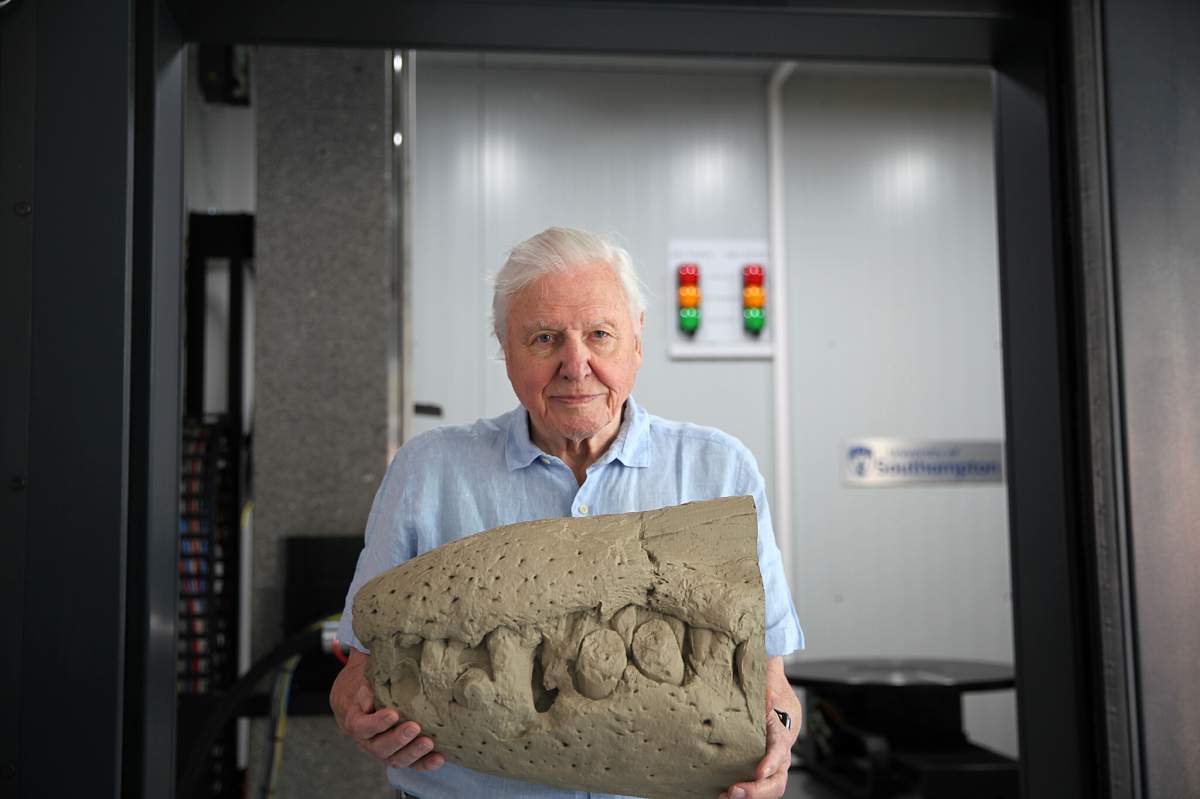Attenborough and the Jurassic Sea Monster sounds like the title of a science-fiction movie, and it’s not that far from reality when you consider the subject matter.

Starring iconic broadcaster and naturalist Sir David Attenborough, the one-hour documentary special (airing Wed., Feb. 14 at 9 p.m. ET/PT on BBC Earth and Prime Video in Canada) investigates the discovery of a lifetime: the skull of a giant sea monster.
The skull belongs to a pliosaur, an enormous prehistoric marine reptile that ruled the seas while dinosaurs reigned on land, approximately 150 million years ago.
Joining Attenborough — now 97 years old — on the dig are two of England’s most intrepid fossil hunters, who excavate the skull from its resting place on the cliff face of Dorset in southern England. Attenborough’s been an avid fossil collector since he was a young boy, but this is the first time he has come across a find quite like this one.
Global News had a brief discussion with Attenborough and executive producer Mike Gunton, who spoke about the movie, the difficulties and joys of fossil hunting and the unprecedented nature of this immense discovery.
Global News: What is this movie about?
David Attenborough: This movie is about the discovery of the skull of an extraordinary monster of the seas — one of the biggest predators the world has ever seen. The skull is the most important part of an animal, and what you can deduce from the skull is absolutely fascinating. Imagine that you were from Mars, and when you landed on Earth all you could find were human skeletons but not a single one with a skull. You wouldn’t know anything about it at all — you wouldn’t know what it fed on, how it could move, you wouldn’t know what it could see — it would be useless.

For people who may not be familiar with the idea of a pliosaur, can you say what it is and how much we know about it?
Well, we know a lot about ichthyosaurs, but this was a great hunter of the ichthyosaurs, and it’s called a pliosaur — an immense animal that ruled the seas during the period of the dinosaurs. It could obviously move at great speed and the teeth that were found in the tip of the skull have vertical ridges down them, which break the suction and allow it to withdraw the jaw from prey quickly. That’s the sort of deduction that we’re able to make and which we show in the program.
Do you remember how you first heard about this?
Yes, I’ve been passionate about collecting fossils since I was a kid and I’ve never given it up. In consequence, I know a number of the collectors and people who live on the Jurassic Coast. One of them, Chris Moore, a long-time friend, got in touch with us and said there’s going to be a remarkable discovery, that this thing had been found.

Get daily National news
It looked as though it was going to be one of the most complete skeletons ever found. The head was only part of it, and that was up in the cliffs. And the body itself, being about the size of a London bus, extends into the cliff. The decision had to be taken that we would go for the skull. The rest of it probably has to be there but it’s 30, 40 feet long, so at the moment we are concentrating on the head, the skull, the most important part.
Mike Gunton: You’re absolutely right about the speed, because we heard they’re going to have to excavate this thing in the next week. So we had to scramble, we had to get it commissioned, we had to get everybody’s involvement, we had to get the crew together, not to mention the really difficult conditions which required health and safety. But nevertheless, within six days we were there!
How much of a challenge was it to excavate the skull?
Well, it weighs over half a ton. That’s a pretty heavy thing to handle. Now, you have to get it out from halfway up the face of a tall cliff which itself is crumbling away, and if you drop it and break it, it’s a major catastrophe. You will have lost a lot of information. So the problem we see in the first part of the film is: how on Earth do you go around getting this out?
They only had a certain length of time because the storms of summer were on the way and fortunately at that time the weather was sunny enough for the team to start working immediately. But they knew that in two or three weeks’ time there was going to be a rainstorm and that could have ruined everything, so they were working against the clock and it was that drama of actually getting it out, the sheer mechanical drama of extracting this thing. You feel the tension as the people are trying to get it out, and do it safely.
What were your first impressions of the whole skull when you saw it for the first time?
Oh, no question about that. That is one of the biggest skulls you’ve ever seen. I mean, it’s huge and so although I was aware of the tip that was first discovered, I hadn’t fully appreciated how big the whole head would be and it’s enormous. So sheer scale was what first impressed me.
Then I talked to the scientists who knew about this particular group of fossils, and pointed out to me the little details, the little pores, sensory pits. There is also the parietal eye — in some animals, including this one, it seems there is a primitive eye in the top of the head.
Think of a crocodile, in the middle, between the eyes at the top. It could have told you which way was up, if you were down in the deep sea; that’s the sort of detail which we weren’t sure about but which this skull has already given us more information about.
How closely did the team collaborate with the scientific community and experts during the making of this movie?
They can tell us all kinds of things. There’s an American expert, Dr. Andre, and he was blown away by it. He said, “It was the most terrifying animal in the seas.”
I asked him perhaps a rather childish question because it was very big, and it’s bigger than the Tyrannosaurus rex by a long way, so I asked this schoolboy question, I said, “Now, supposing Tyrannosaurus rex met this extraordinary pliosaur, who would win?”
And this chap was American and Tyrannosaurus Rex is an American dinosaur, so I expected his answer to be that. He said, “Well, I think it probably was this pliosaur that won.”
Other scientists told us that it’s almost certainly a new species of pliosaur. So it’s a new species, and it would have been able to deal with Tyrannosaurus rex straight up in a fight. So what more do you want?

What made the pliosaur an apex predator?
The facts are dramatic enough that you don’t need to build up pictures with words. … Here is a thing the size of a London bus, moving faster than anything you can imagine of that size, with huge jaws, armed with these extraordinary teeth, which was able to tear apart the ichthyosaurs — there’s no creature alive today in any way comparable to this enormous carnivorous giant.
That’s what sets your imagination alight when you think about it. And of course, the scientists themselves are as thrilled about it, perhaps even more than you will be. It’s a dream of a lifetime.
The pliosaur has one set of flippers at the front and one set at the back, and the scientist pointed out that it’s like geese when they fly, and other birds that migrate in flocks — they fly one behind the other so they can exploit the turbulence and save energy. This is what the pliosaur does by having two flippers one behind the other.
What is it about finding a fossil that holds such fascination for you?
A very basic curiosity but also a sense of privilege. You can tell in many cases because actually, there is a little brown line on a rock that leads you to believe there is something in there. And you can calculate were you should hit it in order to get it to split!
Occasionally, and it’s happened to me, occasionally you will see in complete detail that the rock has split along the junction between a shell and the mud, and it just opens, and there it is, absolutely perfect. It doesn’t require any further excavation, it doesn’t require messing.
There’s this wonderful creature that nobody has seen before you in 150 million years. If you’re young or old, it’s a joy! I’ve never gotten over it, really. It’s very romantic. I mean, people talk about science, the cold, calculating eye of science, which of course you have to have, but it doesn’t prevent you from having romance as well.

Why is it important we study extinct animals, and what can we learn from them?
Knowledge can’t have a cash value. Facts don’t have cash values. It’s just part of life. To know your imagination of the different worlds that once existed, it’s enriching and makes you more appreciative of the fact that you’re alive. The evidence goes back for all these millions of years and that’s part of the meaning of life, really.
—
‘Attenborough and the Jurassic Sea Monster’ airs Wed., Feb. 14 at 9 p.m. ET/PT on BBC Earth in Canada. BBC Earth is also available on Prime Video in Canada, with ‘Attenborough and the Jurassic Sea Monster’ airing simultaneously from Feb. 14 at 9 p.m. ET/PT.











Comments